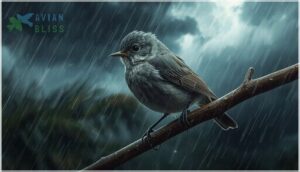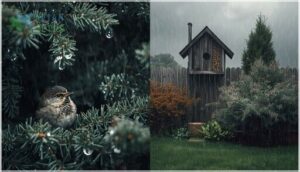This site is supported by our readers. We may earn a commission, at no cost to you, if you purchase through links.
When a storm rolls in, you might instinctively head indoors—but birds don’t have that luxury. They face howling winds, driving rain, and plummeting temperatures with nothing but instinct and adaptation.
During severe weather, up to 90% of songbirds seek refuge in dense shrubs, while waterfowl paddle toward protected coves and woodpeckers hunker down in tree hollows. These aren’t random choices. Birds detect dropping barometric pressure hours before a storm hits, triggering urgent behavioral shifts that can mean the difference between survival and disaster.
Understanding where birds go and how they endure extreme weather reveals the striking strategies they’ve developed—and shows you practical ways to offer safe havens in your own backyard when the skies turn dark.
Table Of Contents
- Key Takeaways
- Where Do Birds Go During Storms?
- How Birds Sense and Prepare for Storms
- Bird Adaptations for Surviving Severe Weather
- Factors Influencing Birds’ Shelter Choices
- How to Help Birds Find Shelter in Storms
- Frequently Asked Questions (FAQs)
- Where do birds hunk in a storm?
- Where do birds go during a storm?
- Where do birds eat in a storm?
- Where do birds go when it rains?
- How do land birds survive a storm?
- Can birds ride out a storm?
- Do birds ever get struck by lightning?
- Can birds survive inside hurricanes or tornadoes?
- What happens to baby birds during storms?
- Do seabirds shelter differently than land birds?
- Conclusion
Key Takeaways
- Birds detect storms hours in advance by sensing drops in barometric pressure through a specialized organ, triggering them to seek shelter in dense shrubs, tree cavities, or protected coves depending on their species.
- Up to 90% of songbirds shelter in dense vegetation during severe weather, while their water-repellent feather structure (with contact angles of 140-150°) and ability to increase caloric intake by 30% before storms help them survive extended periods without food.
- You can significantly improve bird survival during storms by planting native shrubs and trees for natural windbreaks, installing nest boxes with downward-facing entrances to prevent flooding, and maintaining covered feeders with high-energy foods like suet.
- Storm mortality varies dramatically by species and habitat—cavity-nesters face only 18% flooding risk compared to much higher losses for ground-nesters, while habitat fragmentation in urban and rural areas reduces shelter options by up to 25%.
Where Do Birds Go During Storms?
When a storm rolls in, birds don’t just wing it—they head straight for the safest spots they can find. Their choice of shelter depends on their species, size, and what’s available in their environment.
Let’s look at where different birds take cover and how their surroundings shape those decisions.
Typical Sheltering Behaviors by Species
When storms approach, you’ll notice birds responding in species-specific ways. Songbirds like robins and wrens take shelter in dense shrubs—up to 90% seek these havens during heavy weather. Waterfowl such as ducks relocate to protected coves, while cavity-roosting chickadees and woodpeckers hunker down in tree hollows.
These sheltering strategies reflect each species’ unique survival adaptations and pre-storm adjustments in avian behavior. Birds often detect storms by sensing drops in barometric pressure.
Preferred Natural Shelters (Trees, Shrubs, Cavities)
You’ll find most birds use three main natural shelters: trees, shrubs, and cavities. 65% of assessed trees had bird-excavated hollows, and 80% of songbirds choose dense shrubs as windbreaks during heavy rain.
Tree cavity benefits include protection from predators and weather, though cavity-nesting birds face an 18% risk of flooding during severe storms. Birds also use rock crevices for shelter from the elements.
Post-storm return to these mixed shelter spots happens quickly.
Differences in Urban Vs. Rural Bird Sheltering
Where birds seek shelter depends heavily on whether you’re in the city or countryside. Urban birds adapt to man-made structures but still prefer trees—78% chose tree shelters during storms. Rural avian species rely almost entirely on natural habitat like forests and thickets. Human disturbance affects both groups differently:
- Urban birds show faster adaptation strategies to people and buildings
- Habitat fragmentation reduces shelter options in rural areas
- Collision mortality from glass affects city birds more severely
- Shelter type preferences shift based on vegetation density and cover
How Birds Sense and Prepare for Storms
Birds don’t just react to storms—they see them coming. Their bodies pick up on subtle environmental shifts that signal danger long before the first raindrop falls.
Here’s how they sense approaching weather and get ready to ride it out.
Detecting Changes in Air Pressure
You might wonder how birds know a storm’s coming before you do. They detect atmospheric pressure changes through a specialized structure called the Vitalis Organ, which acts like a biological barometer. When barometric pressure drops, birds sense these storm signals immediately.
Research shows white-throated sparrows respond to pressure sensitivity within hours, triggering hormone levels to rise and preparing their bodies for severe weather ahead.
Feeding and Foraging Before Storms
Once pressure drops, you’ll notice your backyard feeders buzzing with activity. Birds ramp up their caloric intake by as much as 30% in the hours before a storm hits, building essential energy reserves.
Species foraging shifts become obvious—chickadees prioritize seeds and suet, while swallows chase descending insects near the ground. This pre-storm feeding frenzy helps birds stockpile enough fuel to weather 24 to 48 hours without access to food sources.
Migration as a Storm Avoidance Strategy
When storms loom, roughly 50% of the world’s bird species rely on migration timing to escape danger. You’ll see migratory birds delay departures for hours—even days—until fronts pass, or adjust route flexibility by flying at altitude changes up to 3,000 meters.
These stopover choices aren’t random. Population impacts from extreme weather show that short-distance migrations and climate-driven shifts help birds survive increasingly severe conditions.
Bird Adaptations for Surviving Severe Weather
Birds don’t just find shelter when storms hit—they’re built for it. Over millions of years, they’ve developed physical traits and behaviors that help them endure wind, rain, and cold.
Let’s look at the key adaptations that keep birds safe when the weather turns rough.
Water-Repellent Feathers and Physical Adaptations
When rain starts pouring, you might wonder how birds stay dry. Feather microstructure is their secret weapon. Duck feathers, for example, show contact angles between 140° and 150°, making them incredibly water-repellent. This avian adaptation comes from microscopic hooks and ridges on barbules that trap air and shed water efficiently.
Here’s how birds use their plumage during storms:
- Overlapping layers: Contour feathers overlap by up to 70%, creating multiple barriers against water infiltration
- Plumage adjustment: Birds fluff up feathers to trap more air and improve water runoff
- Preen gland role: While waxy secretions mainly fight pathogens, preening increases before storms
- Habitat correlation: Aquatic birds possess 15–20% more barbules per millimeter than terrestrial species for enhanced protection
Nesting Choices and Cavity Use
Cavity-nesting birds choose their nesting sites with precision, and that choice can mean the difference between survival and disaster during storms. You’ll notice cavity nesters strongly prefer downward-facing entrances that keep rain out. Natural tree cavities with upward-facing openings accumulate more water, which explains why 11.4% of some nest failures stem from flooding.
| Factor | Impact on Storm Safety |
|---|---|
| Entrance Orientation | Downward entries reduce rain intake by limiting water accumulation |
| Cavity Size | Smaller openings admit less rainfall during severe weather |
| Nesting Materials | Dense linings improve insulation and moisture absorption |
| Reuse Frequency | Repeated use increases flooding risk in poorly oriented cavities |
Cavity competition intensifies where nest selection options are limited, pushing birds toward less protected sites.
Factors Influencing Birds’ Shelter Choices
Not all birds make the same choices when a storm rolls in. What works for a tiny warbler won’t necessarily work for a hawk, and the shelter options in a city park look very different from those in a dense forest.
Several key factors determine where a bird will ride out rough weather.
Species and Size Differences
Not all birds face storms the same way. Species storm survival depends heavily on size-related vulnerability and functional group response. Smaller birds lose heat faster when wet, so they seek shelter quickly. Larger birds can wait out harsh weather more easily. Each species has evolved distinct survival strategies and avian adaptations based on their unique needs.
- Cavity-nesting birds use tree hollows and nest boxes, which protect them better than open nests during severe weather
- Seabirds navigate around storm eyes using sophisticated flight strategies that land birds don’t usually employ
- Ground-nesting species face higher mortality in hail and wind because they lack overhead cover
- Small songbirds must find immediate shelter due to rapid heat loss, while larger birds like vultures sometimes remain exposed
- Migratory species show stronger responses to storm cues, often pausing travel or changing routes to avoid danger
Shelter use differences reflect how storm severity impact varies across species. Open-nesting birds experience greater nest loss during hurricanes compared to cavity-nesters. Understanding these patterns helps you support the most vulnerable birds in your area.
Habitat Availability and Shelter Quality
Your yard’s shelter options matter more than you might think. Habitat fragmentation cuts bird survival during storms by reducing safe refuges. Dense foliage in urban shelters helps—sites with over 50% more nest options see higher bird abundance. Restoration impact is real: wetland projects boost waterfowl densities by 12%.
Vegetation density and man-made shelters both provide critical habitat loss buffers during severe weather.
| Habitat Type | Shelter Quality Impact |
|---|---|
| Dense vegetation | 30% increase in nesting density |
| Fragmented forest | 25% fewer species present |
| Restored wetlands | 12% higher waterfowl populations |
Weather Severity and Storm Type
Storm severity shapes where birds shelter and whether they survive. Tropical storm-force winds reaching 69 mph cause significant mortality rates—over 1,600 pelicans died in a single Texas hailstorm this month. Hurricane-strength events shut down migration for days, while heavy rain and strong winds send birds deep into cavities or dense vegetation.
Storm severity determines survival: tropical-force winds kill thousands of birds, while hurricanes halt migration and drive survivors into deep shelter
Extreme weather hits range-edge populations hardest, with habitat impact reducing some groups by 40%.
How to Help Birds Find Shelter in Storms
You can create a safer environment for birds by making a few thoughtful changes to your yard. Simple additions like the right plants and shelter structures give birds the protection they need when storms roll through.
Here are three practical ways to help birds weather the next storm.
Planting Dense Shrubs and Native Trees
Dense shrubs and native plants create multi-layered planting systems that give birds reliable shelter during storms. By combining tall trees with understory shrubs and evergreens, you’ll establish natural windbreak placement that protects birds from harsh weather.
Native shrub benefits include year-round cover and food sources. Even simple brush pile shelters from yard clippings provide emergency refuge when birds need protection most.
Installing Nest Boxes and Roosting Shelters
Adding birdhouses and roosting boxes to your yard gives cavity-nesting birds safe storm refuges. Box placement matters—approximately 60% of installed nest boxes see regular use when positioned correctly. Design factors like entrance hole size and predator guards protect vulnerable residents. Occupancy rates improve with proper maintenance, and long-term outcomes show that these simple structures help multiple types of bird shelter needs:
- Secure overnight roosting during severe weather
- Emergency refuge when natural cavities are full
- Protected breeding sites with stable temperatures
- Safe spaces away from wind-driven rain
- Community support for declining bird populations
Providing Reliable Food and Water Sources
Beyond shelter, you can support birds by providing food and water during harsh weather. Storm food sources like suet cakes and high-energy seeds in covered bird feeders help when natural food sources are depleted. Heated birdbaths guarantee water source placement near protective cover.
This boosts foraging efficiency and aids post-storm recovery. Food source protection through covered feeders keeps provisions dry and accessible when birds need them most.
Frequently Asked Questions (FAQs)
Where do birds hunk in a storm?
You’ll find birds hunkered in nature’s oldest sanctuaries: tree cavities, dense thickets, and sheltered branches.
Shelter microclimates protect them during immediate survival moments, with species variations determining whether they choose evergreens or undergrowth during storms.
Where do birds go during a storm?
When storms hit, you’ll find most birds tucked into dense shrubs, tree cavities, or protected spots on the downwind side of trunks—natural shelter microclimates that shield them from harsh winds and rain.
Where do birds eat in a storm?
During heavy weather, most birds hunker down in their shelters and don’t eat at all. Foraging becomes too risky—rain grounds insects and wind makes flight dangerous. They rely on fat reserves built up before the storm hits, which is why you’ll notice frantic feeding behavior at your backyard feeder when pressure drops. Storm foraging risks are simply too high for most species.
Once conditions improve, birds emerge quickly. Ground feeders like robins take advantage of earthworms pushed to the surface by rain. That’s when important food sources become important for post-storm recovery. Seed-eating birds visit feeders heavily—studies show up to 70% more activity than normal periods. Human food assistance through maintained feeding stations helps birds bounce back faster, with normal behavior resuming within one to three days if supplemental food is available.
Where do birds go when it rains?
When it rains, you’ll find birds tucked into dense shrubs, tree cavities, and thick foliage. Urban species often use building eaves and ledges, while rural birds depend more heavily on natural vegetation for protection.
How do land birds survive a storm?
When everything goes wrong, birds know exactly what to do. They rely on feather insulation and energy conservation, shelter seeking, flock behavior, and ground nesting adaptations that have kept their survival strategies sharp for millennia.
Can birds ride out a storm?
Yes, birds can ride out storms. Many species have physiological storm adaptations and behavioral coping mechanisms that improve storm survival rates.
Their bird survival strategies include sheltering, building energy reserves, and species resilience factors supporting post-storm recovery.
Do birds ever get struck by lightning?
Lightning strikes do kill birds, though it’s relatively rare. Large flocks near tall trees or open water face the greatest risk, especially when storms hit suddenly and birds can’t reach shelter in time.
Can birds survive inside hurricanes or tornadoes?
Birds rarely survive hurricanes or tornadoes. GPS-tagged brown pelicans seek refuge behind barrier islands during extreme weather events, but tornado bird survival remains low.
Hurricane bird survival depends on sheltering strategies before storm vortex dynamics intensify.
What happens to baby birds during storms?
Baby birds face serious danger during storms. Nestling storm mortality can reach 38% from heavy rainfall alone.
Parental brooding behavior offers some protection, but shelter type effects determine survival—nest boxes dramatically reduce deaths compared to exposed nests.
Do seabirds shelter differently than land birds?
Seabirds and land birds face different habitat constraints during storms. While land birds use stationary shelter like cavities and shrubs, waterbirds often rely on flight adaptations and storm navigation, leading to varied mortality rates and evolutionary pressures.
Conclusion
Think of your yard as a harbor in the storm—a place where weary travelers find refuge when the sky turns hostile. By planting dense cover, installing roosting boxes, and keeping feeders stocked, you create those safe harbors.
Birds will remember. They’ll return, generation after generation, knowing exactly where to go when the next storm arrives. Your choices shape their survival, one sheltered moment at a time.
- https://www.sciencedirect.com/science/article/abs/pii/S0048969722040360
- https://www.audubon.org/news/hurricane-sandy-and-storms-effects-bird-migration
- https://www.harteresearch.org/news/hri-scientists-part-collaboration-assess-extent-bird-mortality-event-after-hailstorm-coastal
- https://envirobites.org/2024/07/18/birds-of-a-feather-flock-to-bad-weather-study-reveals-how-seabirds-chase-cyclones/
- https://www.nsf.gov/news/scientists-track-nighttime-bird-migration-using











